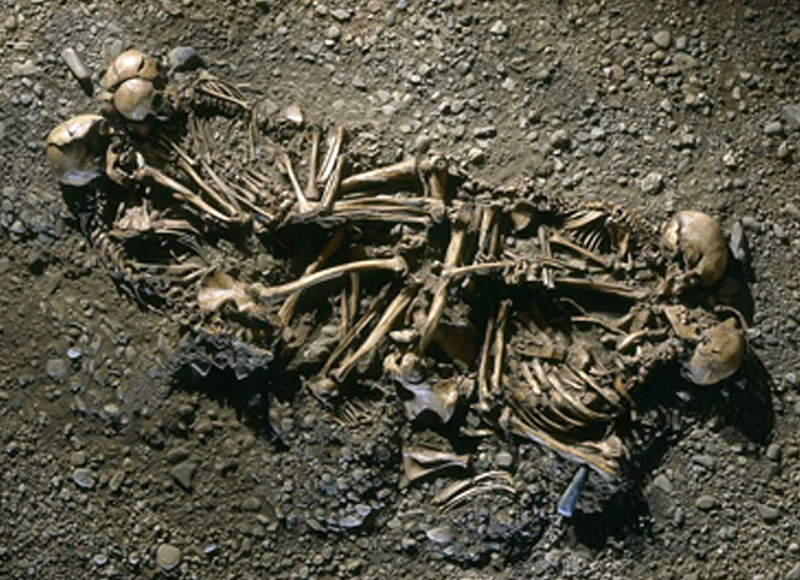In the vast tapestry of human history, archaeology serves as a key tool for unraveling the mysteries of the past. Recently, a groundbreaking discovery in Germany has shed new light on the dynamics of ancient societies. DNA extracted from bones and teeth in a 4600-year-old Stone Age burial site has provided unprecedented insights into the structure of the nuclear family. This finding challenges previous assumptions and offers a fascinating glimpse into the lives of our ancestors.

Exploring the Grave
The burial site, located in Germany, stands as a testament to a bygone era. Within its confines, archaeologists unearthed the remains of four individuals: two adults and two children. Initial analysis indicated that these individuals were victims of a violent conflict, laid to rest together in a poignant display of familial unity. The grave’s discovery intrigued researchers, prompting further investigation into the relationships between these ancient souls.
Unlocking Genetic Secrets
DNA analysis proved instrumental in unraveling the familial ties within the burial site. By studying the genetic material extracted from the bones and teeth of the deceased, scientists gained unprecedented insights into their kinship. Surprisingly, the results revealed that the two adults shared a genetic bond with both children, indicating a nuclear family structure—a ground breaking revelation for a society dating back over four millennia.

Challenging Assumptions: This discovery challenges long-held assumptions about ancient social structures. Previously, scholars speculated that early human societies operated under different familial models, such as communal living arrangements or extended kinship networks. However, the presence of a nuclear family unit in this Stone Age burial site suggests a more complex understanding of ancient social dynamics.
The Significance of Nuclear Families
The emergence of nuclear families carries profound implications for our understanding of human evolution and societal development. The cohesive unit formed by parents and offspring likely played a crucial role in early human communities, providing stability, support, and the foundation for cultural transmission. By nurturing and protecting their offspring, nuclear families fostered the survival and advancement of human societies throughout history.
Insights into Ancient Life
Beyond its implications for social structure, the Stone Age burial site offers a poignant glimpse into the lives of ancient peoples. The presence of multiple generations buried together speaks to the bonds of love and kinship that transcended the ravages of time and conflict. These individuals, though separated from us by millennia, shared the same fundamental desires for connection, belonging, and familial ties.

Conclusion
The discovery of a nuclear family in a 4600-year-old Stone Age burial site in Germany represents a significant milestone in our understanding of ancient societies. Through the meticulous analysis of DNA, researchers have unveiled a portrait of familial life that challenges previous assumptions and underscores the enduring importance of kinship ties throughout human history. As we continue to unearth the secrets of the past, may we approach each discovery with curiosity and humility, recognizing that our ancestors’ stories are woven into the fabric of our own existence.
A small review
In the blog post “Unearthing the Past: DNA Reveals Insights into Ancient Family Dynamics,” the author skillfully explores the groundbreaking discovery of a 4600-year-old Stone Age burial site in Germany. Through a well-structured introduction, body, and conclusion, the post effectively communicates the significance of the finding.
The introduction sets the stage by highlighting the importance of archaeology in uncovering the mysteries of human history. It captivates the reader’s attention and establishes the context for the subsequent discussion.
In the body of the post, the author delves into the specifics of the discovery, providing a detailed examination of the grave and the DNA analysis that revealed the presence of a nuclear family. The explanation of the scientific methods used is clear and accessible, allowing readers to understand the significance of the findings. Additionally, the post effectively discusses how this discovery challenges previous assumptions about ancient social structures, offering a nuanced perspective on human evolution and societal development.
Furthermore, the post eloquently reflects on the broader implications of the discovery, touching on themes of familial bonds, cultural transmission, and the universality of human experience. By drawing parallels between ancient societies and contemporary life, the author underscores the relevance of this historical research to modern understanding.
In the conclusion, the author succinctly summarizes the key points of the post and emphasizes the importance of approaching discoveries with curiosity and humility. This serves as a thoughtful reflection on the nature of archaeological inquiry and the ongoing quest to uncover the secrets of the past.
Overall, “Unearthing the Past: DNA Reveals Insights into Ancient Family Dynamics” is a compelling and informative blog post that effectively communicates the significance of a groundbreaking archaeological discovery. Through its engaging narrative and thoughtful analysis, it invites readers to contemplate the complexities of human history and the enduring relevance of ancient societies.


